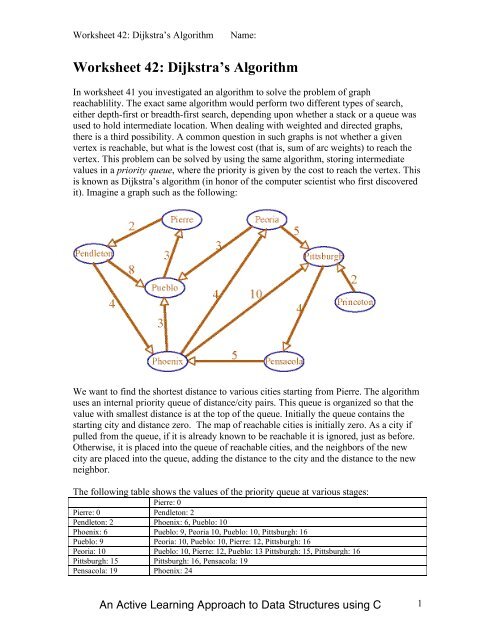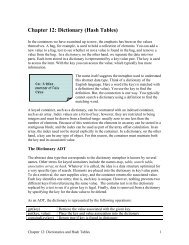Worksheet 42: Dijkstra's Algorithm - Classes
Worksheet 42: Dijkstra's Algorithm - Classes
Worksheet 42: Dijkstra's Algorithm - Classes
You also want an ePaper? Increase the reach of your titles
YUMPU automatically turns print PDFs into web optimized ePapers that Google loves.
<strong>Worksheet</strong> <strong>42</strong>: Dijkstra’s <strong>Algorithm</strong><br />
Name:<br />
<strong>Worksheet</strong> <strong>42</strong>: Dijkstra’s <strong>Algorithm</strong><br />
In worksheet 41 you investigated an algorithm to solve the problem of graph<br />
reachablility. The exact same algorithm would perform two different types of search,<br />
either depth-first or breadth-first search, depending upon whether a stack or a queue was<br />
used to hold intermediate location. When dealing with weighted and directed graphs,<br />
there is a third possibility. A common question in such graphs is not whether a given<br />
vertex is reachable, but what is the lowest cost (that is, sum of arc weights) to reach the<br />
vertex. This problem can be solved by using the same algorithm, storing intermediate<br />
values in a priority queue, where the priority is given by the cost to reach the vertex. This<br />
is known as Dijkstra’s algorithm (in honor of the computer scientist who first discovered<br />
it). Imagine a graph such as the following:<br />
We want to find the shortest distance to various cities starting from Pierre. The algorithm<br />
uses an internal priority queue of distance/city pairs. This queue is organized so that the<br />
value with smallest distance is at the top of the queue. Initially the queue contains the<br />
starting city and distance zero. The map of reachable cities is initially zero. As a city if<br />
pulled from the queue, if it is already known to be reachable it is ignored, just as before.<br />
Otherwise, it is placed into the queue of reachable cities, and the neighbors of the new<br />
city are placed into the queue, adding the distance to the city and the distance to the new<br />
neighbor.<br />
The following table shows the values of the priority queue at various stages:<br />
Pierre: 0<br />
Pierre: 0 Pendleton: 2<br />
Pendleton: 2 Phoenix: 6, Pueblo: 10<br />
Phoenix: 6 Pueblo: 9, Peoria 10, Pueblo: 10, Pittsburgh: 16<br />
Pueblo: 9 Peoria: 10, Pueblo: 10, Pierre: 12, Pittsburgh: 16<br />
Peoria: 10 Pueblo: 10, Pierre: 12, Pueblo: 13 Pittsburgh: 15, Pittsburgh: 16<br />
Pittsburgh: 15 Pittsburgh: 16, Pensacola: 19<br />
Pensacola: 19 Phoenix: 24<br />
An Active Learning Approach to Data Structures using C 1
<strong>Worksheet</strong> <strong>42</strong>: Dijkstra’s <strong>Algorithm</strong><br />
Name:<br />
Notice how duplicates are removed only when pulled from the queue.<br />
Simulate Dijkstra’s algorithm, only this time using Pensacola as the starting city:<br />
An Active Learning Approach to Data Structures using C 2

















